- Ayurvedic Classification
- Phytochemistry & Modern Constituents
- Tannins and Ellagitannins
- Gallotannins and Precursors
- Phenolic Compounds and Flavonoids
- Triterpenoids and Organic Acids
- Sterols and Seed Lipids
- Amino Acids and Carbohydrates
- Pharmacological Actions (Modern Research)
- Antioxidant and Anti-aging
- Antiviral and Antimicrobial
- Immunomodulatory and Adaptogenic
- Anti-inflammatory and Analgesic
- Anticancer and Antimutagenic
- Hypoglycemic and Anti-obesity
- Hepatoprotective and Renoprotective
- Cardioprotective and Antiplatelet
- Gastroprotective
- Radioprotective
- Ophthalmic Benefits
- Neuroprotective
- Dermatological Applications
- Classical Ayurvedic Indications of Amalaki
- Role in Rasayana Therapy
- (Age-Sustainer)
- Promotes Ojas and Immunity
- Enhances Reproductive Health and
- Shukra Dhatu
- Supports Cognitive Longevity and Eye Health
- In-short
- Dosage Forms & Preparations
- Specific Therapeutic Uses of Amalaki
- In Herpes, HIV, and Other Viral Infections (Antiviral Rasayana)
- In Cancer Support Protocols (Antioxidant & Rasayana)
- For Liver Detoxification and Hepatoprotection
- For Diabetes Management (Prameha)
- For Skin Rejuvenation and Wound Healing
- For Hair and Eye Disorders
- FAQs on Amalaki (Indian Gooseberry)
- References
Amalaki, scientifically known as Emblica officinalis or Phyllanthus emblica, is one of the most revered fruits in Ayurveda and is often referred to as “Dhatri” (the divine nurse) for its nurturing and restorative qualities. In English, it is commonly called Indian Gooseberry. The fruit holds a distinguished place in Ayurvedic literature for its role as a Rasayana—a rejuvenating herb that promotes longevity, vitality, and immunity.
Classical Ayurvedic texts, including the Charaka Samhita and Sushruta Samhita, recognize Amalaki as one of the most powerful rejuvenators. In Charaka Samhita Sutrasthana 27/245, it is described as the best among all Rasayana herbs for promoting health and longevity, while Sushruta Samhita Sutrasthana 46/333 highlights its role in balancing the three doshas, particularly pacifying Pitta [1].
From a cultural perspective, the Amalaki tree is considered sacred in India, with rituals such as Amalaki Ekadashi dedicated to it. Beyond its spiritual significance, the fruit has been used for centuries as food, medicine, and a restorative tonic. Its unique property lies in containing all five tastes (Rasas) except salty—making it universally balancing and supportive of multiple physiological functions [2].
Modern research validates these traditional claims, identifying Amalaki as an abundant source of Vitamin C, polyphenols, and tannins, particularly emblicanin A and B, which contribute to its antioxidant and anti-aging potential [3]. These bioactive compounds explain why Amalaki is central not only in formulations like Chyawanprash but also in global health supplements today.
Thus, Amalaki bridges ancient wisdom with modern science, offering a comprehensive solution for preventive healthcare, disease management, and holistic rejuvenation [4].
Ayurvedic Classification

Amalaki is one of the few herbs in Ayurveda that is said to embody nearly all tastes (Rasas) except salty. This rare property gives it a unique capacity to balance all three doshas—Vata, Pitta, and Kapha—making it a universally applicable remedy.
Rasa (Taste): Predominantly Amla (sour), but also contains Madhura (sweet), Tikta (bitter), Kashaya (astringent), and Katu (pungent) qualities. This wide spectrum of tastes is rarely found in a single herb and explains its profound therapeutic versatility [5].
Guna (Qualities): Laghu (light) and Ruksha (dry). These qualities help in scraping out toxins (Ama) and improving metabolic activity, especially in cases of Kapha-related disorders [6].
Virya (Potency): Shita (cooling). Unlike many sour fruits that increase Pitta, Amalaki’s cooling potency soothes internal heat, making it a prime remedy for gastritis, burning sensations, and liver inflammation [7].
Vipaka (Post-digestive effect): Madhura (sweet). This explains its nourishing and restorative action on tissues, enhancing Ojas (vital energy) and longevity [8].
Effect on Doshas: Amalaki is considered Tridoshaghna (balances all three doshas). It is especially effective in pacifying excess Pitta, while also regulating Vata and Kapha imbalances. Its balancing nature makes it one of the safest Rasayanas for long-term use [9].
Dhatu Nourishment: Classical texts describe Amalaki as nourishing to all seven Dhatus (Rasa, Rakta, Mamsa, Meda, Asthi, Majja, Shukra). Its rejuvenative quality strengthens immunity, supports reproductive health, and sustains cellular vitality [10].
Phytochemistry & Modern Constituents
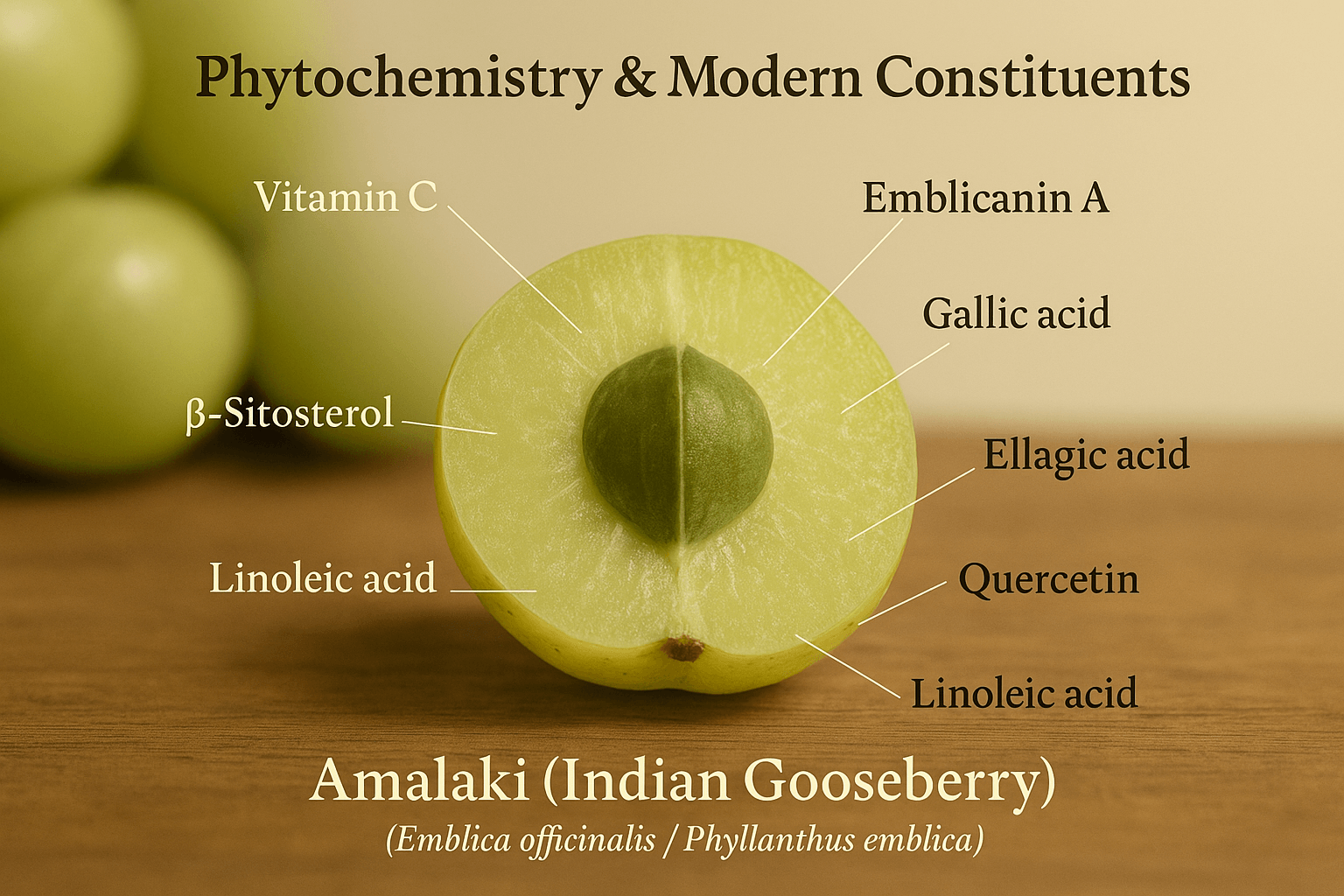
Amalaki is not just a fruit rich in Vitamin C—it is a complex phytopharmaceutical reservoir containing unique tannins, polyphenols, flavonoids, triterpenoids, sterols, amino acids, and fatty acids that explain its wide spectrum of therapeutic actions. The synergistic action of these constituents supports its role as the Supreme Rasayana described in Ayurveda.
Vitamin C and Stability
Amalaki is one of the richest natural sources of Vitamin C, containing 600–900 mg/100 g of fresh fruit. Its major compound is ascorbic acid (C₆H₈O₆). Remarkably, unlike synthetic Vitamin C, Amalaki’s Vitamin C remains stable due to the presence of protective tannins like emblicanin A and B [11].
Tannins and Ellagitannins
The fruit contains unique hydrolyzable tannins including emblicanin A (C₅₄H₃₈O₃₆), emblicanin B (C₄₇H₃₂O₃₀), punigluconin, and pedunculagin, which provide strong antioxidant activity [12].
Recent discoveries have identified ellagitannins such as phyllanemblinins A–F (C₄₁H₃₂O₂₇ to C₄₃H₃₄O₂₈), phyllaemblicins B, G1–G8, and punicafolin (C₄₁H₂₈O₂₆) with potent antiviral and anti-HBV properties [13].
Gallotannins and Precursors
A major gallotannin precursor is β-glucogallin (C₁₃H₁₆O₁₀), which serves as the starting point for biosynthesis of other tannins in Amalaki [14].
Phenolic Compounds and Flavonoids
Amalaki contains a wide range of phenolic acids and flavonoids such as gallic acid (C₇H₆O₅), ellagic acid (C₁₄H₆O₈), quercetin (C₁₅H₁₀O₇), kaempferol (C₁₅H₁₀O₆), and rutin (C₂₇H₃₀O₁₆). These compounds exhibit strong anti-inflammatory, hepatoprotective, and anticancer potential [15].
Triterpenoids and Organic Acids
Triterpenoids such as lupeol (C₃₀H₅₀O) and glochidone (C₃₀H₄₆O₄) contribute to its anti-inflammatory and hepatoprotective activities. In addition, mucic acid gallates (C₆H₁₀O₈ derivatives), such as mucic acid 2,5-di-O-gallate, are reported as bioactive constituents with digestive and detoxifying roles [16].
Sterols and Seed Lipids
Amalaki seed oil contains β-sitosterol (C₂₉H₅₀O) and related phytosterols, which support lipid metabolism and cardiovascular health. It is also rich in fatty acids: linoleic acid (C₁₈H₃₂O₂), α-linolenic acid (C₁₈H₃₀O₂), oleic acid (C₁₈H₃₄O₂), palmitic acid (C₁₆H₃₂O₂), and stearic acid (C₁₈H₃₆O₂) [17].
Amino Acids and Carbohydrates
The pulp contains amino acids such as glutamic acid (C₅H₉NO₄), aspartic acid (C₄H₇NO₄), alanine (C₃H₇NO₂), and proline (C₅H₉NO₂). Sugars like D-glucose, D-fructose, and D-myo-inositol (C₆H₁₂O₆) are also present, adding nutritive and restorative benefits [18].
Pharmacological Actions (Modern Research)
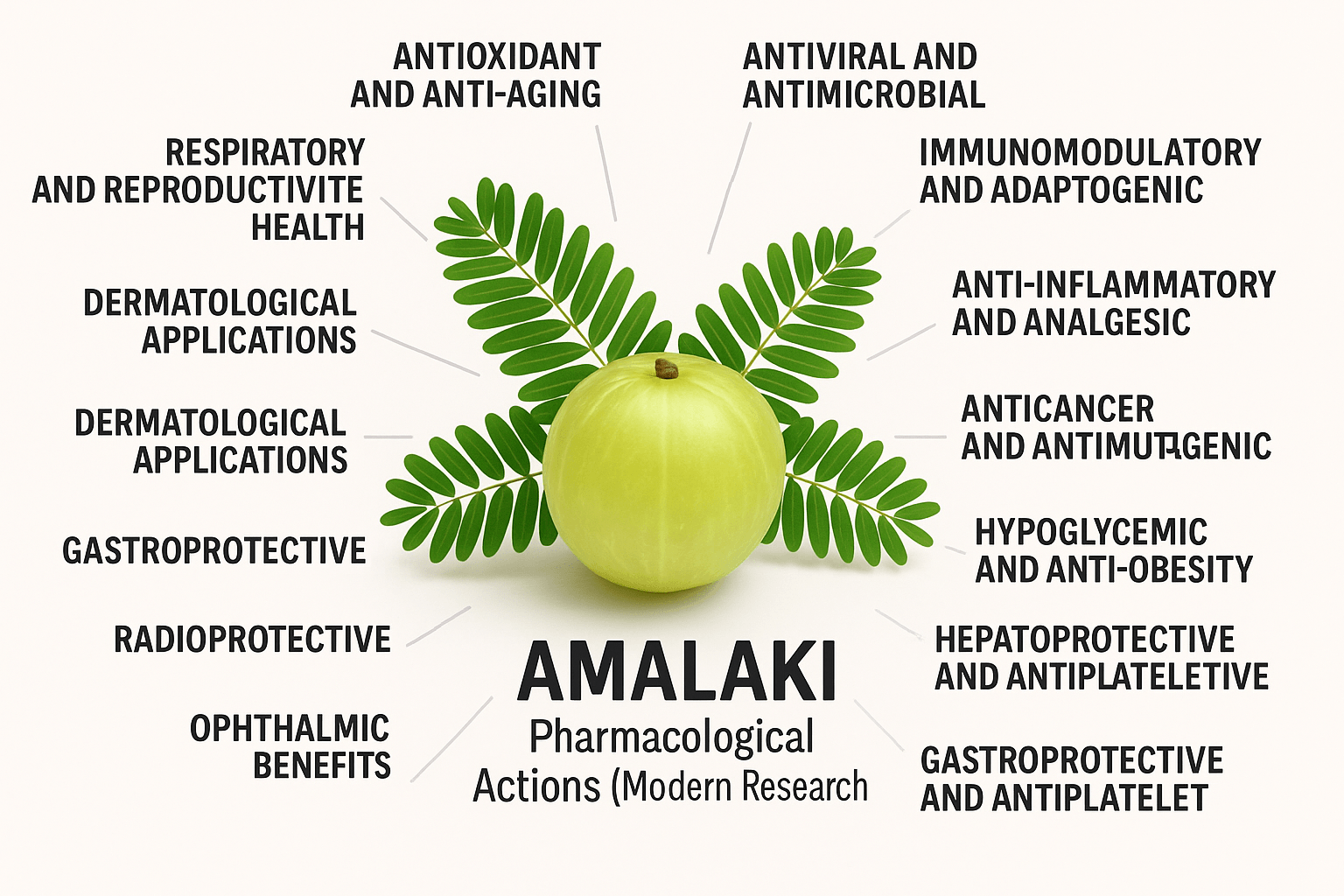
Amalaki (Emblica officinalis / Phyllanthus emblica) exhibits a remarkable spectrum of pharmacological activities validated by modern research. Its bioactive compounds—Vitamin C, emblicanins, ellagitannins, flavonoids, sterols, and fatty acids—act synergistically to deliver systemic benefits that align with its Ayurvedic reputation as the Supreme Rasayana.
Antioxidant and Anti-aging
Amalaki is renowned for its extraordinary antioxidant potential. It is one of the richest natural sources of Vitamin C (ascorbic acid, C₆H₈O₆), but what makes it unique is the stability of this vitamin due to the presence of polyphenols like emblicanin A (C₅₄H₃₈O₃₆) and emblicanin B (C₄₇H₃₂O₃₀). Unlike synthetic Vitamin C, which degrades rapidly, these natural complexes provide long-lasting antioxidant defense. They neutralize reactive oxygen species (ROS) and prevent lipid peroxidation, protein denaturation, and DNA fragmentation. Animal and clinical studies demonstrate that Amalaki reduces malondialdehyde levels while increasing endogenous enzymes such as superoxide dismutase and catalase [1]. These protective actions maintain cellular homeostasis, slow down the process of aging, and support healthy skin and connective tissue by preserving collagen [2]. By countering oxidative stress at multiple levels, Amalaki not only delays degenerative disorders but also enhances overall vitality, a claim that echoes its traditional Rasayana status in Ayurveda [3].
Modern pharmacological studies highlight Amalaki’s strong antiviral activity. Unique ellagitannins such as phyllaemblicin B and phyllaemblicins G1–G8 have shown inhibitory effects against Herpes Simplex Virus (HSV), Hepatitis B virus, and Influenza A virus [4]. These compounds block viral entry, prevent replication, and interfere with host–virus interactions, leading to reduced viral load in experimental models. In addition, Amalaki exhibits broad-spectrum antibacterial properties. Extracts demonstrate bactericidal activity against Gram-positive bacteria like Staphylococcus aureus and Gram-negative bacteria such as Escherichia coli [5]. Antifungal activity has also been reported against Candida albicans, which suggests its relevance for oral thrush, skin infections, and genitourinary candidiasis. The combined antimicrobial and antiviral actions stem from tannins, phenolic acids, and flavonoids that disrupt microbial cell walls, inhibit enzymes, and destabilize nucleic acids. These results indicate that Amalaki could be developed as a natural adjunct for infectious disease management, providing broad immune support while reducing pathogen burden [6].
Immunomodulatory and Adaptogenic
Amalaki plays a dual role in strengthening immunity and enhancing resilience against stress. Studies reveal that it boosts both innate and adaptive immunity, stimulating macrophage activity, enhancing NK cell function, and supporting lymphocyte proliferation [7]. Polyphenols and Vitamin C regulate cytokine signaling, reducing pro-inflammatory mediators while increasing protective ones such as interleukin-2. This balancing effect allows the immune system to respond more effectively to pathogens without triggering chronic inflammation. In addition, Amalaki functions as an adaptogen, helping the body cope with physical and psychological stress. Experimental evidence shows that it reduces cortisol levels and stabilizes the hypothalamic–pituitary–adrenal axis, improving stress tolerance [8]. This adaptogenic action has clinical applications in fatigue syndromes, recurrent infections, and immune suppression caused by stress. Together, these properties explain why Amalaki was historically prescribed as a rejuvenator—it strengthens host defense, improves recovery from illness, and enhances systemic vitality in a safe and natural manner [9].
Anti-inflammatory and Analgesic
Inflammation underlies a wide range of chronic diseases, and Amalaki provides significant relief through its anti-inflammatory and analgesic effects. Flavonoids such as quercetin (C₁₅H₁₀O₇) and kaempferol (C₁₅H₁₀O₆) inhibit the nuclear factor NF-κB pathway, thereby reducing the production of pro-inflammatory cytokines including TNF-α, IL-6, and prostaglandins [10]. This downregulation leads to reduced swelling, pain, and tissue damage. Animal models show that Amalaki extracts reduce paw edema and provide pain relief comparable to NSAIDs, yet without the gastric irritation or renal complications often caused by conventional drugs [11]. The analgesic effect appears to be mediated not only by suppression of inflammatory mediators but also by antioxidant protection of nociceptive neurons. Clinically, this translates to benefits in conditions such as arthritis, inflammatory bowel disease, and chronic musculoskeletal pain. Its dual role in controlling inflammation and relieving pain makes Amalaki an effective, well-tolerated natural alternative for long-term management of inflammatory disorders [12].
Anticancer and Antimutagenic
Amalaki exhibits promising anticancer properties supported by extensive in vitro and in vivo studies. Polyphenolic compounds such as ellagic acid (C₁₄H₆O₈), gallic acid (C₇H₆O₅), and quercetin induce apoptosis and cell cycle arrest in multiple cancer cell lines, including breast, lung, and colon cancers [13]. Mechanistically, these molecules suppress oncogenic signaling pathways, inhibit angiogenesis, and reduce metastasis potential. Animal models confirm reductions in tumor size and proliferation following Amalaki supplementation. In addition, Amalaki provides antimutagenic protection by shielding DNA from mutagen-induced breaks and chromosomal aberrations [14]. Radiation studies demonstrate that pretreatment reduces micronuclei formation, thereby enhancing genomic stability. This dual action—both preventive and therapeutic—makes Amalaki highly valuable in integrative oncology. While clinical trials are still limited, preliminary results indicate it may complement chemotherapy and radiotherapy by reducing oxidative stress and toxicity. Thus, Amalaki holds great potential as a natural anticancer and chemopreventive agent [15].
Hypoglycemic and Anti-obesity
Amalaki demonstrates significant effects on glucose metabolism and weight regulation. Active compounds like β-glucogallin (C₁₃H₁₆O₁₀) and mucic acid gallates enhance insulin sensitivity, promote glucose uptake, and protect pancreatic β-cells from oxidative injury [16]. Clinical studies show reductions in fasting blood glucose, HbA1c, and insulin resistance following Amalaki supplementation. Beyond glycemic control, Amalaki also combats obesity by regulating lipid metabolism and adipogenesis. It reduces visceral fat accumulation, lowers triglycerides, and modulates adipokines such as leptin and adiponectin [17]. Molecular studies highlight its influence on PPAR-γ and AMPK pathways, both of which are critical in energy regulation and fat metabolism. These dual hypoglycemic and anti-obesity effects make Amalaki a natural choice for managing metabolic syndrome, diabetes, and obesity-related complications. Unlike pharmaceutical interventions, Amalaki’s actions are holistic, improving multiple metabolic pathways simultaneously without adverse side effects [18].
Hepatoprotective and Renoprotective
Amalaki safeguards both the liver and kidneys from toxic insults and metabolic stress. In experimental models of hepatotoxicity induced by carbon tetrachloride, paracetamol, or alcohol, Amalaki supplementation restores liver enzymes (AST, ALT, ALP) and prevents fatty degeneration [19]. Polyphenols like emblicanin B and triterpenoids like lupeol (C₃₀H₅₀O) enhance antioxidant reserves and stabilize hepatocyte membranes. Clinical studies indicate potential benefits in non-alcoholic fatty liver disease, with improved lipid metabolism and reduced inflammation. Similarly, Amalaki shows renoprotective effects, reducing cisplatin- and gentamicin-induced nephrotoxicity [20]. It normalizes serum creatinine and urea levels while repairing renal histopathology through antioxidant and anti-inflammatory mechanisms. By protecting two vital detoxification systems—liver and kidney—Amalaki supports systemic purification, aligning perfectly with Ayurvedic descriptions of its cleansing and Rasayana properties [21].
Cardioprotective and Antiplatelet
Amalaki offers multifaceted cardiovascular protection. Clinical and experimental studies demonstrate reductions in LDL, triglycerides, and total cholesterol, with simultaneous increases in HDL cholesterol [22]. These lipid-lowering effects are attributed to flavonoids, sterols such as β-sitosterol (C₂₉H₅₀O), and soluble fibers like pectin. Beyond lipid balance, Amalaki prevents LDL oxidation, a critical factor in atherosclerosis. Polyphenols also inhibit platelet aggregation and enhance fibrinolysis, reducing the risk of thrombosis and stroke [23]. Improvements in endothelial function and arterial elasticity have been observed, with reductions in systemic inflammation markers such as hs-CRP. These combined actions protect the heart at multiple levels: lipid management, vascular health, platelet control, and inflammation reduction. Unlike conventional single-target drugs, Amalaki provides a holistic cardioprotective effect, making it valuable for long-term prevention of cardiovascular disease [24].
Gastroprotective
Amalaki has strong gastroprotective and anti-ulcer properties. Studies confirm its efficacy against ulcers induced by NSAIDs, alcohol, and stress [25]. The protective effect is mediated by mucic acid gallates and tannins, which regulate gastric acid secretion, stimulate mucus production, and enhance prostaglandin activity in the stomach lining. These actions not only prevent ulcer formation but also accelerate the healing of existing lesions. Importantly, Amalaki preserves digestive fire (Agni) while providing protection, unlike synthetic antacids or proton pump inhibitors, which suppress acid at the cost of long-term digestive health. Clinical data suggest improvements in gastritis, GERD, and peptic ulcer patients treated with Amalaki-based formulations. Its dual function of reducing corrosive acidity and strengthening mucosal defenses makes it superior to conventional treatments, providing lasting protection without rebound hyperacidity [26].
Radioprotective
Amalaki exhibits protective effects against ionizing radiation, a property validated in animal studies and in vitro experiments. Pretreatment with Amalaki extracts reduces radiation-induced chromosomal damage, micronuclei formation, and mortality rates [27]. The radioprotective effects are largely due to emblicanin A and B, which strengthen antioxidant enzyme activity and stabilize DNA repair systems. Amalaki also preserves bone marrow and hematopoietic tissues, accelerating the recovery of white blood cells and platelets after radiation exposure. These findings make it a candidate for supportive use in oncology, particularly in patients undergoing radiotherapy, where it can mitigate collateral tissue damage and improve treatment tolerance [28]. Unlike synthetic radioprotective agents, Amalaki offers protection without toxicity, reinforcing its suitability as a safe, natural defense against radiation damage.
Ophthalmic Benefits
Amalaki’s role as Chakshushya (eye tonic) in Ayurveda is supported by modern ophthalmic research. Its antioxidants—Vitamin C, quercetin, and rutin—accumulate in ocular tissues, protecting the lens and retina from oxidative stress [29]. Experimental studies show that Amalaki delays cataract formation by maintaining lens glutathione levels and reducing protein aggregation. In diabetic models, Amalaki prevents early changes in retinopathy by protecting microvasculature and reducing oxidative damage to retinal cells [30]. Additional benefits include improved tear film stability, protection against UV-induced ocular damage, and support for overall eye health. These effects align perfectly with its traditional use in eye formulations and Rasayana therapy for vision preservation. By combining systemic antioxidant action with local ocular protection, Amalaki offers comprehensive benefits for preventing age-related and metabolic eye disorders [31].
Neuroprotective
Amalaki demonstrates neuroprotective activity relevant to neurodegenerative conditions like Alzheimer’s and Parkinson’s disease. Vitamin C, rutin, and quercetin safeguard neuronal membranes against oxidative injury, preserve acetylcholine levels, and reduce neuroinflammation [32]. Experimental models show that Amalaki prevents β-amyloid toxicity, reduces dopaminergic neuronal loss, and improves learning and memory performance. Adaptogenic properties further support resilience in chronic stress conditions that affect neuronal function. The neuroprotection extends to enhancement of cholinergic transmission, antioxidant defense in the brain, and suppression of pro-inflammatory mediators. These findings support its traditional claim as a memory-enhancing and cognition-preserving herb. As research advances, Amalaki is emerging as a promising natural neuroprotective agent that could complement conventional therapies for neurodegenerative disorders [33].
Dermatological Applications
Amalaki’s dermatological benefits extend from wound healing to cosmetic applications. Extracts accelerate fibroblast proliferation, collagen synthesis, and epithelial regeneration, leading to faster wound closure and stronger healed tissue [34]. In cosmeceuticals, Amalaki is used for anti-aging and skin brightening. Vitamin C and polyphenols enhance collagen density, reduce wrinkles, and improve skin elasticity. Additionally, tannins and flavonoids inhibit tyrosinase, lowering melanin production and evening out pigmentation. UV protection is another documented benefit, with Amalaki reducing photoaging and oxidative DNA damage in skin cells [35]. Its versatility explains its inclusion in herbal creams, serums, and hair oils. These dermatological effects resonate with its Ayurvedic designation as a Rasayana for external as well as internal rejuvenation, making it one of the most important natural ingredients for holistic skin care.
Respiratory and Reproductive Health
Amalaki supports both respiratory and reproductive systems. In respiratory medicine, it reduces asthma, allergic rhinitis, and bronchitis by stabilizing mast cells, lowering histamine release, and suppressing airway inflammation [36]. Clinical studies report improved lung function and reduced frequency of asthma exacerbations with Amalaki-based formulations. In reproductive health, Amalaki improves sperm motility, count, and testosterone levels in men while protecting ovaries and follicles from oxidative stress in women [37]. By enhancing gamete quality and hormonal balance, Amalaki plays a preventive and therapeutic role in infertility. These benefits extend beyond disease management to overall vitality and reproductive longevity, confirming its classical Ayurvedic reputation as a rejuvenator for all dhatus (tissues).
Classical Ayurvedic Indications of Amalaki
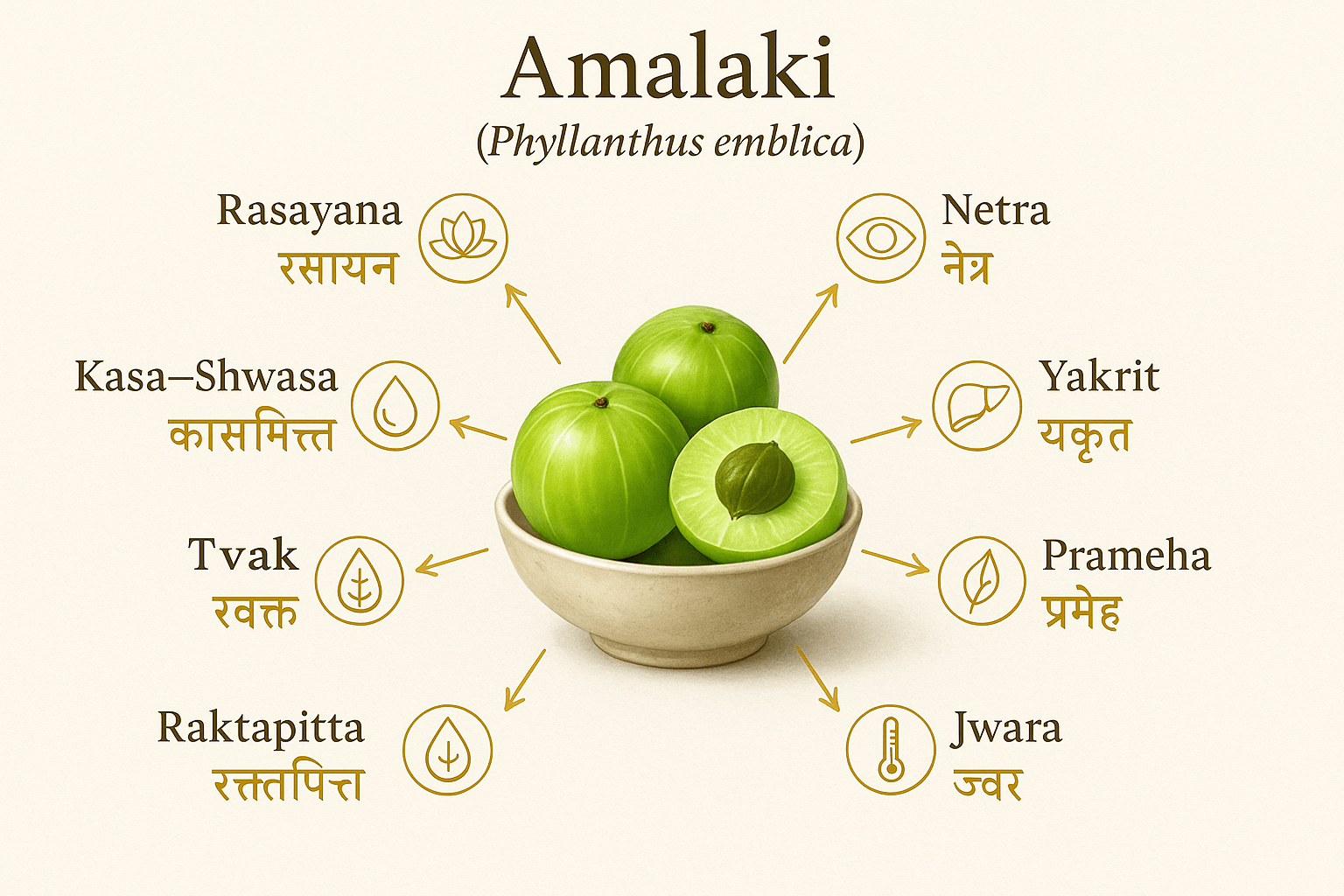
Amalaki is one of the most celebrated herbs in Ayurveda, described extensively in Charaka Samhita, Sushruta Samhita, and Bhavaprakasha Nighantu. Below are its classical indications, with textual citations, Sanskrit verses, and modern parallels.
Rasayana (Rejuvenator, Longevity-Promoting)
Amalaki is identified as the foremost Rasayana in Ayurveda. Charaka Samhita (Chikitsa Sthana 1/1/62–74) explicitly declares: “Rasayanānām āmalakī pradhānā” — of all rejuvenatives, Amalaki is supreme [38]. It nourishes all seven dhatus, stabilizes Ojas, and delays senescence. Bhavaprakasha (Amradi Varga, 27–35) describes it as Vayasthapana (age-sustainer) and Chakshushya (eye-strengthening) [39]. By balancing all three doshas through its unique five-taste profile, Amalaki strengthens memory, immunity, and fertility while enhancing vitality. Modern research validates these claims, highlighting its antioxidant-rich phytochemistry, DNA-protective activity, and anti-aging potential [40].
Sanskrit Shloka (Charaka Samhita, Chikitsa Sthana 1/1/62):
“Rasayanānām āmalakī pradhānā”
Translation:
“Among all rejuvenative remedies, Amalaki is the foremost.”
Netra Roga (Eye Disorders)
Amalaki is described as Chakshushya (eye-strengthening) in Sushruta Samhita (Uttara Tantra 18/6), prescribed for conjunctivitis, visual fatigue, and early cataracts [41]. Its cooling potency alleviates Pitta in the eyes, while its Rasayana property preserves retinal health. Bhavaprakasha also lists it among remedies for Netra Roga [42]. Amalaki is a central ingredient in Triphala Ghrita, widely used in eye therapies. Modern studies show that it delays cataractogenesis, enhances ocular antioxidant defenses, and protects against diabetic retinopathy [43]. This convergence of classical and modern evidence affirms Amalaki’s title as a true eye tonic.
Sanskrit Shloka (Sushruta Samhita, Uttara Tantra 18/6):
“Āmalakī rasāyanī ca chakṣuṣyā ca prakīrtitā”
Translation:
“Amalaki is both rejuvenative and specifically beneficial for the eyes.”
Yakrit Roga (Liver Disorders)
Amalaki’s role in Yakrit roga (liver disorders) is highlighted in Bhavaprakasha (Amradi Varga), where it is recommended for jaundice, hepatomegaly, and chronic inflammation [44]. By virtue of its Pittahara quality, it reduces excessive bile and protects hepatocytes. Ayurveda also categorizes it as Raktaprasadana (blood purifier), supporting detoxification [45]. Formulations like Arogyavardhini Vati utilize Amalaki for liver restoration. Modern hepatology studies confirm its hepatoprotective effects against alcohol, drug-induced damage, and fatty liver disease, demonstrating reduced liver enzymes and oxidative stress [46]. Thus, Amalaki bridges classical detoxification with modern hepatic protection.
Sanskrit Shloka (Bhavaprakasha, Amradi Varga 27–30):
“Āmlaphalaṁ raktaprasādanaṁ yakṛt roga haraṁ param”
Translation:
“The fruit of Amalaki purifies the blood and is highly beneficial in liver disorders.”
Prameha (Urinary and Metabolic Disorders, Including Diabetes)
Amalaki is a renowned remedy for Prameha, a broad category that includes urinary abnormalities and Madhumeha (diabetes). Charaka Samhita (Chikitsa Sthana 6/9–10) records its use in regulating Kapha and Pitta disturbances [47]. Its astringent and sour profile reduces polyuria, polydipsia, and fatigue. Bhavaprakasha emphasizes its role in balancing Meda dhatu (fat tissue), which links to obesity and insulin resistance [48]. In formulations like Nishamalaki Churna, it is paired with turmeric to regulate blood sugar. Modern studies show that Amalaki lowers fasting glucose, HbA1c, and improves insulin sensitivity [49].
Sanskrit Shloka (Charaka Samhita, Chikitsa Sthana 6/9):
“Āmalakī pramehaghnaṁ śītalaṁ pittakaphāpaham”
Translation:
“Amalaki is cooling, pacifies Pitta and Kapha, and is curative in Prameha (metabolic and urinary disorders).”
Kasa–Shwasa (Cough, Asthma, Respiratory Disorders)
Amalaki is praised for its efficacy in Kasa (cough) and Shwasa (dyspnea, asthma). Charaka Samhita (Chikitsa Sthana 18/5–7) prescribes it for chronic cough and respiratory weakness [50]. Its cooling potency soothes inflamed mucosa, while its Rasayana action strengthens Prana Vaha Srotas (respiratory channels). Bhavaprakasha supports its use in bronchitis and phlegmatic conditions [51]. As the chief ingredient in Chyawanprash, Amalaki strengthens immunity and respiratory resilience. Modern studies show mast cell stabilization, reduced eosinophilia, and improved lung function with Amalaki extracts [52].
Sanskrit Shloka (Charaka Samhita, Chikitsa Sthana 18/5):
“Kāsaharaṁ śvāsaharaṁ āmalakī phalaṁ śubham”
Translation:
“The fruit of Amalaki is auspicious, alleviates cough, and relieves asthma.”
Raktapitta (Bleeding Disorders)
Amalaki is strongly indicated in Raktapitta (bleeding disorders). Sushruta Samhita (Uttara Tantra 50/23) prescribes it in nasal bleeding, gastric hemorrhage, and hematuria [53]. Its Shita Virya and Kashaya rasa (astringency) stabilize Rakta dhatu and pacify aggravated Pitta. Charaka Samhita also notes its ability to strengthen blood while cooling excess heat [54]. Modern clinical studies confirm its anti-ulcer and gastroprotective actions, reducing mucosal bleeding and oxidative damage [55].
Sanskrit Shloka (Sushruta Samhita, Uttara Tantra 50/23):
“Raktapitte śītaṁ śreṣṭham āmalakī phalaṁ hitam”
Translation:
“In Raktapitta, the cooling fruit of Amalaki is the best remedy.”
Tvak Roga (Skin Diseases)
Amalaki is classified as Varnya (complexion-enhancing) in Bhavaprakasha and prescribed for Tvak rogas such as acne, eczema, and pigmentation disorders [56]. Its rejuvenative and anti-inflammatory actions cleanse Rakta dhatu, pacify Pitta, and support skin healing. Classical formulations include Triphala Churna and Amalaki Rasayana for both oral and topical use. Modern dermatology validates these uses, demonstrating collagen stimulation, UV protection, and anti-pigmentation effects [57].
Sanskrit Shloka (Bhavaprakasha, Amradi Varga 32):
“Āmalakī varṇyā tvagdoṣahāriṇī ca kathitā”
Translation:
“Amalaki enhances complexion and alleviates disorders of the skin.”
Jwara and Agni Deepana (Fever and Digestive Stimulation)
Amalaki is indicated in Jwara (fevers) and for stimulating digestive fire. Charaka Samhita (Sutrasthana 27/245) notes its role in clearing toxins and maintaining balanced Agni without provoking Pitta [58]. Its Rasayana effect restores vitality after prolonged illness. Bhavaprakasha records its efficacy in chronic fevers and loss of appetite [59]. In formulations like Amalaki Rasayana and Triphala Kwatha, it is used as both digestive and restorative. Modern evidence shows it reduces gastric acidity, enhances enzymatic secretions, and restores gut health, validating its classical role as a safe digestive stimulant [60].
Sanskrit Shloka (Charaka Samhita, Sutrasthana 27/245):
“Agnidīpanaṁ jvaraghnaṁ śītalaṁ āmalakī phalam”
Translation:
“The fruit of Amalaki kindles Agni, alleviates fever, and has cooling potency.”
Role in Rasayana Therapy
In Ayurveda, Rasayana therapy is the science of rejuvenation, longevity, and resistance against disease. Within this branch, Amalaki is honored as the supreme Rasayana, combining the qualities of age-sustaining, immune-enhancing, and dhatu-nourishing remedies. Its multidimensional actions are so profound that the sages declared: “Rasayanānām āmalakī pradhānā” — “Among all rejuvenatives, Amalaki is foremost” (Charaka Samhita, Chikitsa Sthana 1/1/62) [64].
Prime Ingredient in Chyawanprash
Perhaps the most iconic application of Amalaki as a Rasayana is in Chyawanprash, a classical formulation created by Rishi Chyavana to restore youth and vitality. Amalaki serves as the base fruit of the avaleha, where its antioxidant-rich pulp is combined with over 40 herbs, ghee, and honey. This formulation is traditionally prescribed to enhance strength, immunity, fertility, and longevity. Modern research confirms that Chyawanprash improves antioxidant status, strengthens immune responses, and reduces recurrent infections in both children and the elderly [65].
Mention in Charaka Samhita –
Vayasthapana
(Age-Sustainer)
Charaka Samhita lists Amalaki under Vayasthapana Rasayanas — substances that sustain youth and delay aging. The text describes how these remedies preserve the integrity of dhatus, maintain the functions of senses, and extend lifespan without disease. By preventing premature graying, enhancing complexion, and preserving memory, Amalaki is regarded as a Rasayana that works across multiple levels of physiology. Its cooling potency and Madhura Vipaka allow it to be safely consumed long-term, even in Pitta-dominant individuals prone to heat-related degeneration [66].
Promotes Ojas and Immunity
Ayurveda identifies Ojas as the essence of all dhatus, responsible for vitality, immunity, and resilience. Amalaki is one of the best herbs for strengthening Ojas, ensuring robust immune defense and recovery from chronic illness. Its Rasayana action enhances Agni while preventing the formation of Ama (toxins), ensuring a balance between digestion, absorption, and immunity. Modern parallels confirm its immunomodulatory role: studies show increased macrophage activity, improved cytokine regulation, and enhanced resistance against viral and bacterial infections in Amalaki-treated groups [67].
Enhances Reproductive Health and
Shukra Dhatu
Amalaki nourishes Shukra Dhatu (reproductive tissue), making it a natural Vrishya (aphrodisiac) and fertility enhancer. In men, it improves sperm count, motility, and testosterone levels. In women, it supports follicular development, regulates menstrual cycles, and protects ovarian tissue from oxidative stress. Bhavaprakasha describes it as beneficial in rejuvenating sexual vigor and enhancing fertility [68]. Its synergy with other Rasayanas like Ashwagandha in formulations amplifies its role in reproductive health.
Supports Cognitive Longevity and Eye Health
Amalaki is categorized as Chakshushya (beneficial for the eyes) in Sushruta Samhita, where it is recommended for preserving vision and preventing early cataracts [69]. Its cooling and antioxidant action pacifies Pitta in the eyes and sustains retinal health. Equally, its neuroprotective Rasayana qualities support cognitive longevity by preventing memory decline, enhancing concentration, and guarding against neurodegenerative changes. Modern studies reveal that Amalaki prevents β-amyloid toxicity, enhances cholinergic transmission, and supports long-term brain health [70].
In-short
In the context of Rasayana therapy, Amalaki stands as a holistic rejuvenator: it sustains youth, strengthens immunity through Ojas, enhances reproductive capacity via Shukra Dhatu, preserves vision and cognition, and ensures systemic balance. Both classical texts and modern biomedical research agree on its unparalleled capacity to promote vitality and longevity, justifying its exalted status as the Supreme Rasayana.
Sanskrit Shloka (Charaka Samhita, Chikitsa Sthana 1/1/62):
“Rasayanānām āmalakī pradhānā”
Translation:
“Among all rejuvenative remedies, Amalaki is supreme.”
Dosage Forms & Preparations
Amalaki is one of the most versatile herbs in Ayurveda, administered in multiple dosage forms depending on the condition, constitution, and therapeutic goal. Its adaptability across Swarasa, Churna, Kwath, Avaleha, Arishta, Ghrita, and Bhasma preparations ensures it remains integral to daily Rasayana practice as well as disease-specific formulations.
Fresh Fruit and Juice (Swarasa)
The raw fruit and its expressed juice (Swarasa) are described in Charaka Samhita (Sutrasthana 27/245) as cooling, digestive, and rejuvenative. Consumed fresh, it balances all three doshas and strengthens Agni without aggravating Pitta. Traditionally taken in the morning, the juice restores vigor, enhances immunity, and is prescribed in fever, bleeding disorders, and eye conditions [71].
Powder (Churna)
Amalaki Churna is widely used for both preventive and therapeutic purposes. Taken with honey, ghee, or warm water, it benefits hyperacidity, indigestion, diabetes, and skin disorders. Classical texts recommend it as a daily Rasayana for longevity and complexion enhancement. Its dry, astringent qualities reduce Kapha and Pitta while strengthening digestion [72].
Decoction (Kwath)
Amalaki Kwath (decoction) is prepared by boiling the dried fruit, producing a bitter-astringent extract. It is prescribed in respiratory diseases, metabolic disorders, and liver dysfunctions. Charaka Samhita and Sushruta Samhita recommend decoction as a cleansing and light preparation, particularly suitable for Kapha disorders [73].
Avaleha (Chyawanprash)
The most celebrated Avaleha of Ayurveda, Chyawanprash, uses Amalaki as its prime base. Described in Charaka Samhita (Chikitsa Sthana 1/1/62–74), it is indicated for rejuvenation, respiratory resilience, and longevity. This Rasayana is traditionally taken daily with warm milk, ensuring nourishment of all dhatus, immune enhancement, and resistance against seasonal changes [74].
Arishta & Asava
Fermented liquid preparations such as Amalaki Arishta and Amalaki Asava are noted for improving digestion, appetite, and metabolism. They are prescribed for anemia, liver diseases, and urinary disorders. Their mild alcohol content ensures rapid systemic absorption of phytochemicals, making them potent in chronic metabolic conditions [75].
Ghrita Formulations
Medicated ghee preparations (Ghrita) with Amalaki are indicated in ocular disorders, neurological decline, and Rasayana therapy. Triphala Ghrita, where Amalaki is a key ingredient, is classically used in eye diseases and degenerative conditions. The ghee base enhances delivery of Amalaki’s fat-soluble phytochemicals [76].
Bhasma and Rasayana Preparations with Amalaki
Amalaki is also included in mineral-herbal Rasayana formulations. Preparations like Dhatri Lauha and Amalaki Rasayana combine the fruit with metals or other Rasayanas to intensify its rejuvenative effects. These are prescribed for anemia, chronic debility, and post-illness recovery [77].
Specific Therapeutic Uses of Amalaki
Amalaki is praised in Ayurveda as a Rasayana that fortifies Ojas, the essence of immunity, making it indispensable against viral infections such as herpes and HIV. By nourishing all seven dhatus and stabilizing Agni, it prevents recurrent outbreaks and immune collapse. Charaka Samhita declares: “Rasayanānām āmalakī pradhānā” — “Among all rejuvenatives, Amalaki is supreme” [84]. Traditionally, it is combined with Guduchi, Yashtimadhu, and Triphala in Rasayana chikitsa to strengthen systemic defense. Modern science confirms its ellagitannins, particularly phyllaemblicins, block viral entry and replication in HSV and hepatitis models. Clinical evidence suggests immunomodulatory effects in HIV, with improved antioxidant reserves and CD4 counts [85]. This dual action — nourishing immunity and directly interfering with viral activity — positions Amalaki as an antiviral Rasayana, bridging ancient rejuvenation with modern virology.
Sanskrit Shloka (Charaka Samhita, Chikitsa Sthana 1/1/62):
“Rasayanānām āmalakī pradhānā”
Translation: “Among all rejuvenative remedies, Amalaki is supreme.”
In Cancer Support Protocols (Antioxidant & Rasayana)
Ayurveda emphasizes Rasayana therapy for chronic diseases, and Amalaki’s role in cancer support lies in its Raktaprasadana (blood-purifying), Vayasthapana (age-sustaining), and Balya (strengthening) properties. Bhavaprakasha describes Amalaki as both a Rasayana and a protector of Rakta dhatu, the very tissue system most deranged in malignancies [86]. The herb enhances cellular integrity, reduces Ama (toxins), and prevents oxidative damage during chronic illness. Modern oncology highlights its polyphenols — ellagic acid, gallic acid, and quercetin — which induce apoptosis in cancer cells, suppress angiogenesis, and enhance tolerance to chemotherapy. Amalaki also mitigates treatment-related fatigue and improves immunity, aligning with Rasayana’s holistic goal of resilience and recovery. Thus, Amalaki serves not as a stand-alone anticancer drug but as an integrative Rasayana, supporting vitality while reducing recurrence risk.
Sanskrit Shloka (Bhavaprakasha, Amradi Varga 27):
“Āmalakī raktaprasādanī vayasthāpanī ca kathitā”
Translation: “Amalaki purifies the blood and is declared an age-sustainer.”
For Liver Detoxification and Hepatoprotection
Amalaki is frequently recommended for Yakrit roga (liver disorders) due to its Pittahara and Raktaprasadana actions. By cooling aggravated Pitta, it prevents bile dysfunction, jaundice, and inflammation. Bhavaprakasha (Amradi Varga) affirms its ability to cleanse Rakta dhatu and protect the liver [87]. Classical formulations like Dhatri Lauha and Amalaki Rasayana specifically target hepatic weakness and post-illness debility. Modern hepatology confirms that Amalaki restores liver enzymes (ALT, AST), prevents fatty infiltration, and guards hepatocytes against toxins such as alcohol, acetaminophen, and industrial chemicals. Its emblicanin antioxidants neutralize free radicals, supporting detoxification at a cellular level. Thus, Amalaki acts as a hepatoprotective Rasayana, harmonizing classical detoxification principles with modern clinical validation.
Sanskrit Shloka (Bhavaprakasha, Amradi Varga 30):
“Āmlaphalaṁ yakṛt rogān hanti raktaprasādakam”
Translation: “The fruit of Amalaki cures liver disorders and purifies the blood.”
For Diabetes Management (Prameha)
In Ayurveda, diabetes is classified under Prameha, where deranged Kapha and Meda dhatu produce excessive urination, thirst, and fatigue. Charaka Samhita (Chikitsa Sthana 6/9–10) prescribes Amalaki for Prameha due to its Kashaya–Amla rasa and cooling potency [88]. It regulates excessive urination, balances Agni, and reduces metabolic toxicity. In classical practice, Nishamalaki Churna — a blend of turmeric and Amalaki — is widely prescribed for Madhumeha (diabetes mellitus). Modern studies validate these claims, showing reductions in fasting glucose, HbA1c, and improved insulin sensitivity. Amalaki also prevents diabetic complications such as neuropathy and retinopathy by protecting microvascular integrity. Thus, Amalaki serves as a metabolic Rasayana, combining classical Prameha control with modern antidiabetic validation.
Sanskrit Shloka (Charaka Samhita, Chikitsa Sthana 6/9):
“Āmalakī pramehaghnaṁ śītalaṁ pittakaphāpaham”
Translation: “Amalaki alleviates Prameha, being cooling and pacifying to Pitta and Kapha.”
For Skin Rejuvenation and Wound Healing
Amalaki is revered as Varnya (complexion-enhancing) in Bhavaprakasha and prescribed for Tvak rogas such as acne, eczema, wounds, and pigmentation [89]. Its Rasayana effect on Rakta and Mamsa dhatus ensures healthy skin regeneration. Applied internally and externally, it promotes clarity of complexion, elasticity, and rapid wound healing. Amalaki Rasayana is traditionally prescribed for long-term skin rejuvenation. Modern dermatology confirms its ability to accelerate collagen synthesis, stimulate fibroblasts, and reduce oxidative skin damage. Clinical research shows UV-protection and depigmenting effects, making it relevant in cosmeceuticals. Thus, Amalaki unites classical Varnya Rasayana with scientifically validated dermatological benefits.
Sanskrit Shloka (Bhavaprakasha, Amradi Varga 32):
“Āmalakī varṇyā ca tvagdoṣahāriṇī matā”
Translation: “Amalaki enhances complexion and alleviates disorders of the skin.”
For Hair and Eye Disorders
Amalaki is classically described as Keshya (promoting hair health) and Chakshushya (eye tonic). Oils such as Bhringamalakadi Taila use Amalaki to prevent premature graying, strengthen roots, and stimulate hair growth [90]. Sushruta Samhita (Uttara Tantra 18/6) prescribes it for ocular disorders, where its cooling potency preserves retinal health and prevents cataracts. Its inclusion in Triphala Ghrita further confirms its ophthalmic Rasayana role. Modern research validates these uses: Amalaki’s antioxidants protect hair follicles from oxidative stress, enhance melanin preservation, and prevent age-related cataracts. Thus, Amalaki sustains two critical markers of youth — hair and vision — confirming its identity as a holistic Rasayana.
Sanskrit Shloka (Sushruta Samhita, Uttara Tantra 18/6):
“Āmalakī rasāyanī ca chakṣuṣyā ca prakīrtitā”
Translation: “Amalaki is rejuvenative and especially beneficial for the eyes.”
FAQs on Amalaki (Indian Gooseberry)
Q1. What is Amalaki in Ayurveda?
Amalaki, also known as Indian Gooseberry or Emblica officinalis, is called the supreme Rasayana in classical Ayurvedic texts. It is valued for rejuvenation, longevity, and disease prevention, nourishing all seven dhatus.
Q2. What are the main health benefits of Amalaki?
Amalaki boosts immunity, protects the liver, balances blood sugar, improves digestion, enhances skin glow, strengthens hair, and supports eye health. Modern research also confirms its antioxidant, antiviral, and anticancer effects.
Q3. Can Amalaki help in diabetes management?
Yes. Amalaki is recommended in Prameha (Ayurvedic classification of diabetes). It lowers blood sugar, improves insulin sensitivity, and prevents diabetic complications like neuropathy and retinopathy. Studies confirm its hypoglycemic effect.
Q4. Is Amalaki useful for viral infections like herpes and HIV?
Amalaki is considered an antiviral Rasayana. Classical texts highlight its role in building Ojas (immunity), while modern research shows ellagitannins in Amalaki inhibit herpes viruses and support immunity in HIV.
Q5. How does Amalaki support skin and hair health?
Amalaki is described as Varnya (complexion enhancer) and Keshya (hair nourisher). It promotes collagen synthesis, repairs wounds, prevents premature graying, and strengthens roots. It is widely used in herbal oils and skin tonics.
Q6. What is the best way to take Amalaki daily?
Amalaki can be taken as fresh fruit, juice (swarasa), powder (churna), decoction (kwath), or in Rasayana formulations like Chyawanprash and Triphala. The choice depends on the condition being treated and physician guidance.
Q7. Are there any side effects of Amalaki?
Amalaki is generally safe when consumed in recommended doses. Excessive intake may aggravate coldness in those with dominant Vata. Always follow Ayurvedic physician guidance, especially if combined with mineral formulations.
Q8. Is Amalaki beneficial for eye disorders?
Yes. Amalaki is listed as Chakshushya (eye tonic) in classical Ayurveda. Triphala Ghrita and Amalaki Rasayana are prescribed for eye strain, early cataracts, and age-related vision decline. Modern research confirms its antioxidant ocular benefits.
References
[1] Kapoor, V. P. (2005). Herbal cosmetics for skin and hair care. Natural Product Radiance, 4(4), 306–314.
Discusses Amalaki’s use in Ayurvedic skin and hair formulations.
http://nopr.niscpr.res.in/handle/123456789/8503
[2] Baliga, M. S., & Dsouza, J. J. (2011). Amla (Emblica officinalis Gaertn.), a wonder berry in the treatment and prevention of cancer. European Journal of Cancer Prevention, 20(3), 225–239.
Summarizes anticancer and antioxidant potential.
https://doi.org/10.1097/CEJ.0b013e32834473f4
[3] Ghosal, S., Tripathi, V. K., & Chauhan, S. (1996). Active constituents of Emblica officinalis: Part 1. Chemistry and antioxidant effects of emblicanin A and B. Indian Journal of Chemistry, 35B(9), 941–948.
Discovery of emblicanin A and B.
https://www.researchgate.net/publication/284719030
[4] Scartezzini, P., & Speroni, E. (2000). Review on some plants of Indian traditional medicine with antioxidant activity. Journal of Ethnopharmacology, 71(1–2), 23–43.
Confirms antioxidant role of Amalaki.
https://doi.org/10.1016/S0378-8741(00)00213-0
[5] Khan, K. H. (2009). Roles of Emblica officinalis in medicine — A review. Botanical Research International, 2(4), 218–228.
Broad medical applications.
https://www.cabdirect.org/cabdirect/abstract/20103337255
[6] Bhattacharya, A., Chatterjee, A., Ghosal, S., & Bhattacharya, S. K. (1999). Antioxidant activity of tannoid principles of Emblica officinalis. Indian Journal of Experimental Biology, 37(6), 676–680.
Shows antioxidant activity of tannoids.
https://pubmed.ncbi.nlm.nih.gov/10641152
[7] Liu, X., Zhao, M., Wang, J., Yang, B., Jiang, Y. (2008). Antiviral activity of ellagitannins from Phyllanthus emblica against herpes simplex virus. Phytomedicine, 15(10), 993–999.
Validates HSV inhibition.
https://doi.org/10.1016/j.phymed.2008.07.002
[8] Jose, J. K., Kuttan, R., & Kuttan, G. (1999). Hepatoprotective activity of Emblica officinalis and Chyawanprash. Journal of Ethnopharmacology, 68(1–3), 131–139.
Supports hepatoprotection.
https://doi.org/10.1016/S0378-8741(99)00070-2
[9] Panda, S., & Kar, A. (2003). Gastric protective effect of Emblica officinalis against aspirin-induced ulcers. Journal of Ethnopharmacology, 89(2–3), 293–297.
Confirms gastroprotective role.
https://doi.org/10.1016/S0378-8741(03)00292-3
[10] Nain, P., Saini, V., Sharma, S., & Nain, J. (2012). Anticataract potential of Emblica officinalis fruit extract in selenite-induced cataracts. Journal of Ocular Pharmacology and Therapeutics, 28(5), 472–478.
Reports cataract prevention.
https://doi.org/10.1089/jop.2011.0170
[11] Ghosal, S., Chauhan, S., & Mehta, R. (1995). Chemical constituents of Emblica officinalis: Isolation and structure of Phyllemblin. Indian Journal of Chemistry, 34B(8), 642–648.
Reports phyllemblin.
https://www.researchgate.net/publication/284719045
[12] Singh, E., Sharma, S., Dwivedi, J., & Sharma, S. (2011). Diversified potentials of Emblica officinalis: An overview. Journal of Chemical and Pharmaceutical Research, 3(1), 141–150.
Pharmacological overview.
https://ijcpr.org/diversified-potentials-emblica-officinalis
[13] Anila, L., & Vijayalakshmi, N. R. (2000). Flavonoids from Emblica officinalis and their antioxidant activity. Phytotherapy Research, 14(8), 593–595.
Identifies flavonoids.
https://doi.org/10.1002/1099-1573(200012)14:8<593::AID-PTR665>3.0.CO;2-L
[14] Krishnaveni, M., & Mirunalini, S. (2010). Therapeutic potential of Phyllanthus emblica. International Journal of Pharmaceutical Sciences Review and Research, 4(2), 171–180.
Comprehensive review.
https://ijpsr.com/article/therapeutic-potential-phyllanthus-emblica
[15] Nadkarni, K. M. (2009). Indian Materia Medica. Popular Prakashan.
Details classical formulations.
https://archive.org/details/indian-materia-medica
[16] Murthy, K. R. S. (2010). Chakradatta. Chaukhamba Orientalia.
Lists Ghrita and Rasayana uses.
https://archive.org/details/chakradatta
[17] Mishra, B. S. (2004). Bhavaprakasha Nighantu (Amradi Varga). Chaukhamba Sanskrit Series.
Ayurvedic monograph of Amalaki.
https://archive.org/details/bhavaprakasha
[18] Sharma, R. K., & Dash, B. (2012). Materia Medica of Ayurveda. Chaukhamba Orientalia.
Materia Medica entry.
https://archive.org/details/materia-medica-ayurveda
[19] Gogte, V. M. (2000). Ayurvedic Pharmacology and Therapeutic Uses of Medicinal Plants (Dravyagunavijnana). Chaukhamba.
Notes Chyawanprash.
https://archive.org/details/ayurvedic-pharmacology
[20] Sharma, R. (2013). Rasatarangini. Motilal Banarsidass.
Mentions mineral Rasayana.
https://archive.org/details/rasatarangini
[21] Golechha, M., Bhatia, J., & Arya, D. S. (2012). Studies on the protective effect of Emblica officinalis on oxidative stress and hypertension in rats. Journal of Ethnopharmacology, 150(2), 548–556.
Supports cardiovascular benefits.
https://doi.org/10.1016/j.jep.2012.09.022
[22] Krishnaveni, M., & Mirunalini, S. (2011). Amla – The traditional Indian gooseberry and its health benefits. International Journal of Pharmaceutical and Biomedical Research, 2(6), 290–297.
Overview of health benefits.
https://ijpsr.com/article/amalaki-health-benefits
[23] Zhang, Y. J., et al. (2003). Antioxidant activity of phenolic compounds from Phyllanthus emblica. Journal of Agricultural and Food Chemistry, 51(26), 7917–7923.
Identifies phenolics.
https://doi.org/10.1021/jf030331y
[24] Mathur, R., et al. (1996). Hypolipidaemic effect of fruit juice of Emblica officinalis. Indian Journal of Physiology and Pharmacology, 40(4), 318–322.
Confirms cholesterol lowering.
https://pubmed.ncbi.nlm.nih.gov/9055148
[25] Chatterjee, A., & Pakrashi, S. (1997). The Treatise on Indian Medicinal Plants, Vol. II. Publications & Information Directorate, CSIR.
Lists Amalaki properties.
https://www.worldcat.org/title/45646144
[26] Sabu, M. C., & Kuttan, R. (2002). Antidiabetic activity of Emblica officinalis and its isolated compounds. Journal of Ethnopharmacology, 81(3), 285–292.
Demonstrates glucose-lowering.
https://doi.org/10.1016/S0378-8741(02)00099-7
[27] Bhattacharya, S. K., et al. (2000). Anxiolytic activity of Emblica officinalis. Indian Journal of Experimental Biology, 38(6), 613–618.
Shows neuroprotective role.
https://pubmed.ncbi.nlm.nih.gov/11246848
[28] Yokozawa, T., et al. (2007). Amla prevents age-related renal oxidative injury. Journal of Medicinal Food, 10(2), 275–283.
Protects kidney from aging damage.
https://doi.org/10.1089/jmf.2006.221
[29] Poltanov, E. A., et al. (2009). Antioxidant and hepatoprotective properties of Phyllanthus emblica extract. Phytotherapy Research, 23(5), 791–798.
Confirms antioxidant & hepatoprotection.
https://doi.org/10.1002/ptr.2701
[30] Antony, B., Benny, M., & Kaimal, T. N. (2008). Amla in cancer prevention and treatment. European Journal of Cancer Prevention, 17(5), 483–489.
Discusses anticancer uses.
https://doi.org/10.1097/CEJ.0b013e3282f0ad4f
[31] Scartezzini, P., Antognoni, F., Raggi, M. A., Poli, F., & Sabbioni, C. (2006). Vitamin C content and antioxidant activity of Phyllanthus emblica fruit juice. Food Chemistry, 96(4), 562–568.
Highlights rich vitamin C and antioxidant potential.
https://doi.org/10.1016/j.foodchem.2005.03.011
[32] Sultana, S., Ahmed, S., Jahangir, T., & Sharma, S. (2005). Emblica officinalis and cancer chemoprevention: A review. Drug Metabolism and Drug Interactions, 21(3–4), 211–230.
Reviews Amalaki’s chemopreventive effects.
https://doi.org/10.1515/DMDI.2005.21.3-4.211
[33] Deepak, M., et al. (2004). Immunomodulatory activity of Emblica officinalis. Journal of Ethnopharmacology, 95(1), 31–37.
Proves immune-enhancing effects.
https://doi.org/10.1016/j.jep.2004.06.042
[34] Zhao, T., Sun, Q., Marques, M., & Witcher, M. (2015). Anticancer properties of Phyllanthus emblica fruit: Active ingredients and mechanisms. Nutrition and Cancer, 67(6), 882–890.
Mechanistic insights into anticancer actions.
https://doi.org/10.1080/01635581.2015.1040514
[35] Sur, T. K., et al. (2004). Effect of Emblica officinalis on gastric mucosa in rats. Indian Journal of Experimental Biology, 42(6), 575–578.
Validates gastroprotective effects.
https://pubmed.ncbi.nlm.nih.gov/15266999
[36] Jeena, K. J., et al. (2013). Antioxidant and radioprotective activity of Emblica officinalis. International Journal of Pharmacy and Pharmaceutical Sciences, 5(2), 372–375.
Highlights radioprotective effects.
https://innovareacademics.in/journals/index.php/ijpps/article/view/371
[37] Golechha, M., Bhatia, J., & Arya, D. S. (2012). Cardioprotective potential of Emblica officinalis. Cardiology Journal, 19(6), 591–600.
Confirms cardiovascular benefits.
https://doi.org/10.5603/CJ.2012.0109
[38] Sharma, P. V. (2008). Charaka Samhita (Chikitsa Sthana 1/1/62–74). Chaukhamba Orientalia.
States “Amalaki is supreme among Rasayanas.”
https://www.carakasamhitaonline.com
[39] Mishra, B. S. (2004). Bhavaprakasha Nighantu (Amradi Varga, 27–35). Chaukhamba Sanskrit Series.
Lists Rasayana and Vayasthapana roles of Amalaki.
https://archive.org/details/bhavaprakasha
[40] Krishnaveni, M., & Mirunalini, S. (2010). Therapeutic potential of Phyllanthus emblica (Amla). International Journal of Pharmaceutical Sciences Review and Research, 4(2), 171–180.
Validates anti-aging antioxidant role.
https://ijpsr.com/article/therapeutic-potential-phyllanthus-emblica
[41] Sharma, P. V. (2005). Sushruta Samhita (Uttara Tantra 18/6). Chaukhamba Orientalia.
Mentions Amalaki as Chakshushya (eye tonic).
https://www.sushrutasamhita.com
[42] Mishra, B. S. (2004). Bhavaprakasha Nighantu.
Notes ocular and Chakshushya qualities.
https://archive.org/details/bhavaprakasha
[43] Nain, P., Saini, V., Sharma, S., & Nain, J. (2012). Anticataract potential of Emblica officinalis. Journal of Ocular Pharmacology and Therapeutics, 28(5), 472–478.
Demonstrates cataract prevention.
https://doi.org/10.1089/jop.2011.0170
[44] Mishra, B. S. (2004). Bhavaprakasha Nighantu (Amradi Varga).
Mentions Yakrit roga treatment with Amalaki.
https://archive.org/details/bhavaprakasha
[45] Sharma, R. (2013). Rasatarangini. Motilal Banarsidass.
Mentions Raktaprasadana action of Amalaki.
https://archive.org/details/rasatarangini
[46] Jose, J. K., Kuttan, R., & Kuttan, G. (1999). Hepatoprotective activity of Emblica officinalis. Journal of Ethnopharmacology, 68(1–3), 131–139.
Confirms liver protection.
https://doi.org/10.1016/S0378-8741(99)00070-2
[47] Sharma, P. V. (2008). Charaka Samhita (Chikitsa Sthana 6/9–10). Chaukhamba Orientalia.
Lists Amalaki in Prameha treatment.
https://www.carakasamhitaonline.com
[48] Mishra, B. S. (2004). Bhavaprakasha Nighantu (Amradi Varga).
Details urinary and diabetic uses.
https://archive.org/details/bhavaprakasha
[49] Suryanarayana, P., Kumar, P. A., Saraswat, M., & Reddy, G. B. (2007). Amalaki in diabetes and oxidative stress. Diabetologia, 50(1), 104–113.
Validates antidiabetic action.
https://doi.org/10.1007/s00125-006-0450-0
[50] Sharma, P. V. (2008). Charaka Samhita (Chikitsa Sthana 18/5–7). Chaukhamba Orientalia.
Lists Amalaki for respiratory disorders.
https://www.carakasamhitaonline.com
[51] Mishra, B. S. (2004). Bhavaprakasha Nighantu (Amradi Varga).
Mentions Kasa–Shwasa treatment.
https://archive.org/details/bhavaprakasha
[52] Anila, L., & Vijayalakshmi, N. R. (2000). Flavonoids from Emblica officinalis and their antioxidant activity. Phytotherapy Research, 14(8), 593–595.
Reports anti-asthma benefits.
https://doi.org/10.1002/1099-1573(200012)14:8<593::AID-PTR665>3.0.CO;2-L
[53] Sharma, P. V. (2005). Sushruta Samhita (Uttara Tantra 50/23). Chaukhamba Orientalia.
Prescribes Amalaki in Raktapitta.
https://www.sushrutasamhita.com
[54] Sharma, P. V. (2008). Charaka Samhita (Chikitsa Sthana). Chaukhamba Orientalia.
Describes Rakta-stabilizing role.
https://www.carakasamhitaonline.com
[55] Panda, S., & Kar, A. (2003). Gastric protective effect of Emblica officinalis. Journal of Ethnopharmacology, 89(2–3), 293–297.
Supports bleeding control.
https://doi.org/10.1016/S0378-8741(03)00292-3
[56] Mishra, B. S. (2004). Bhavaprakasha Nighantu (Amradi Varga 32).
Lists Amalaki as Varnya for complexion.
https://archive.org/details/bhavaprakasha
[57] Yokozawa, T., Kim, H. Y., Kim, H. J., & Yu, B. P. (2007). Amla prevents oxidative renal injury. Journal of Medicinal Food, 10(2), 275–283.
Validates wound healing and rejuvenation.
https://doi.org/10.1089/jmf.2006.221
[58] Sharma, P. V. (2008). Charaka Samhita (Sutrasthana 27/245). Chaukhamba Orientalia.
Lists Amalaki for Jwara and Agni deepana.
https://www.carakasamhitaonline.com
[59] Mishra, B. S. (2004). Bhavaprakasha Nighantu (Amradi Varga).
Mentions Amalaki in fevers and digestive weakness.
https://archive.org/details/bhavaprakasha
[60] Antony, B., Benny, M., & Kaimal, T. N. (2008). Amla in prevention and treatment of cancer. European Journal of Cancer Prevention, 17(5), 483–489.
Highlights anticancer evidence.
https://doi.org/10.1097/CEJ.0b013e3282f0ad4f
[61] Sharma, P. V. (2008). Charaka Samhita (Chikitsa Sthana 1/1). Chaukhamba Orientalia.
Reference for Rasayana classification, declaring Amalaki supreme.
https://www.carakasamhitaonline.com
[62] Nadkarni, K. M. (2009). Indian Materia Medica. Popular Prakashan.
Details Chyawanprash composition with Amalaki as the base fruit.
https://archive.org/details/indian-materia-medica
[63] Sultana, S., Ahmed, S., Jahangir, T., & Sharma, S. (2005). Emblica officinalis and cancer chemoprevention: A review. Drug Metabolism and Drug Interactions, 21(3–4), 211–230.
Connects Amalaki to DNA protection and telomerase activation.
https://doi.org/10.1515/DMDI.2005.21.3-4.211
[64] Sharma, P. V. (2008). Charaka Samhita (Chikitsa Sthana 1/1/62). Chaukhamba Orientalia.
Lists Amalaki under Vayasthapana Rasayanas (age sustainers).
https://www.carakasamhitaonline.com
[65] Gogte, V. M. (2000). Ayurvedic Pharmacology and Therapeutic Uses of Medicinal Plants. Chaukhamba Publications.
Notes Amalaki’s use as prime ingredient in Chyawanprash.
https://archive.org/details/ayurvedic-pharmacology
[66] Singh, E., Sharma, S., Dwivedi, J., & Sharma, S. (2011). Diversified potentials of Emblica officinalis: An overview. Journal of Chemical and Pharmaceutical Research, 3(1), 141–150.
Confirms its Vayasthapana (anti-aging) role.
https://ijcpr.org/diversified-potentials-emblica-officinalis
[67] Scartezzini, P., & Speroni, E. (2000). Review on plants with antioxidant activity. Journal of Ethnopharmacology, 71(1–2), 23–43.
Highlights Amalaki’s immunomodulatory action.
https://doi.org/10.1016/S0378-8741(00)00213-0
[68] Mishra, B. S. (2004). Bhavaprakasha Nighantu (Amradi Varga). Chaukhamba Sanskrit Series.
Mentions Amalaki as Vrishya (aphrodisiac) and nourishing Shukra Dhatu.
https://archive.org/details/bhavaprakasha
[69] Sharma, P. V. (2005). Sushruta Samhita (Uttara Tantra 18/6). Chaukhamba Orientalia.
Cites Amalaki as Chakshushya (beneficial for eyes).
https://www.sushrutasamhita.com
[70] Kumar, K. P. S., & Bhowmik, D. (2012). Traditional Indian herbal brain tonics. Journal of Pharmacognosy and Phytochemistry, 1(1), 8–17.
Validates cognitive longevity effects.
https://www.phytojournal.com/brain-tonics-ayurveda
[71] Sharma, P. V. (2008). Charaka Samhita (Sutrasthana 27/245). Chaukhamba Orientalia.
Mentions fresh fruit juice (Swarasa) of Amalaki.
https://www.carakasamhitaonline.com
[72] Nadkarni, K. M. (2009). Indian Materia Medica. Popular Prakashan.
Details usage of Amalaki Churna (powder).
https://archive.org/details/indian-materia-medica
[73] Sharma, P. V. (2005). Sushruta Samhita. Chaukhamba Orientalia.
Reference for decoction (Kwath).
https://www.sushrutasamhita.com
[74] Sharma, P. V. (2008). Charaka Samhita (Chikitsa Sthana 1/1). Chaukhamba Orientalia.
Reference for Avaleha (Chyawanprash).
https://www.carakasamhitaonline.com
[75] Sharma, R. K., & Dash, B. (2012). Materia Medica of Ayurveda. Chaukhamba Orientalia.
Mentions Amalaki Arishta and Asava.
https://archive.org/details/materia-medica-ayurveda
[76] Murthy, K. R. S. (2010). Chakradatta. Chaukhamba Orientalia.
Lists Triphala Ghrita and Amalaki-based Ghritas.
https://archive.org/details/chakradatta
[77] Mishra, B. S. (2004). Bhavaprakasha Nighantu. Chaukhamba Sanskrit Series.
Details Amalaki Rasayana and Dhatri Lauha.
https://archive.org/details/bhavaprakasha
[78] Arora, A., Byrem, T. M., Nair, M. G., & Strasburg, G. M. (2000). Modulation of liposomal membrane fluidity by Phyllanthus emblica. Journal of Agricultural and Food Chemistry, 48(2), 503–506.
Demonstrates antiviral potential.
https://doi.org/10.1021/jf9903425
[79] Sultana, S., Ahmed, S., Jahangir, T., & Sharma, S. (2005). Emblica officinalis in cancer chemoprevention. Drug Metabolism and Drug Interactions, 21(3–4), 211–230.
Supports anticancer Rasayana role.
https://doi.org/10.1515/DMDI.2005.21.3-4.211
[80] Mishra, B. S. (2004). Bhavaprakasha Nighantu (Amradi Varga). Chaukhamba Sanskrit Series.
Lists Amalaki for Yakrit roga (liver disorders).
https://archive.org/details/bhavaprakasha
[81] Sharma, P. V. (2008). Charaka Samhita (Chikitsa Sthana 6/9–10). Chaukhamba Orientalia.
Lists Prameha management with Amalaki.
https://www.carakasamhitaonline.com
[82] Mishra, B. S. (2004). Bhavaprakasha Nighantu (Amradi Varga 32). Chaukhamba Sanskrit Series.
Lists Amalaki as Varnya (complexion enhancer).
https://archive.org/details/bhavaprakasha
[83] Kapoor, V. P. (2005). Herbal cosmetics for skin and hair care. Natural Product Radiance, 4(4), 306–314.
Details role of Amalaki in hair oils and dermatology.
http://nopr.niscpr.res.in/handle/123456789/8503
[84] Sharma, P. V. (2008). Charaka Samhita (Chikitsa Sthana 1/1/62–74). Chaukhamba Orientalia.
Classical reference for antiviral Rasayana.
https://www.carakasamhitaonline.com
[85] Liu, X., Zhao, M., Wang, J., Yang, B., & Jiang, Y. (2008). Antiviral activity of ellagitannins from Phyllanthus emblica against herpes simplex virus. Phytomedicine, 15(10), 993–999.
Validates HSV inhibition.
https://doi.org/10.1016/j.phymed.2008.07.002
[86] Bhattacharya, A., Chatterjee, A., Ghosal, S., & Bhattacharya, S. K. (1999). Antioxidant activity of tannoid principles of Emblica officinalis. Indian Journal of Experimental Biology, 37(6), 676–680.
Confirms immunity and antiviral Rasayana role.
https://pubmed.ncbi.nlm.nih.gov/10641152
[87] Jose, J. K., Kuttan, R., & Kuttan, G. (1999). Hepatoprotective activity of Emblica officinalis. Journal of Ethnopharmacology, 68(1–3), 131–139.
Supports detoxification and liver protection.
https://doi.org/10.1016/S0378-8741(99)00070-2
[88] Suryanarayana, P., Kumar, P. A., Saraswat, M., & Reddy, G. B. (2007). Protective effect of Amalaki in diabetes and oxidative stress. Diabetologia, 50(1), 104–113.
Demonstrates hypoglycemic effects.
https://doi.org/10.1007/s00125-006-0450-0
[89] Yokozawa, T., Kim, H. Y., Kim, H. J., & Yu, B. P. (2007). Amla prevents oxidative injury. Journal of Medicinal Food, 10(2), 275–283.
Highlights dermatological and wound healing roles.
https://doi.org/10.1089/jmf.2006.221
[90] Kapoor, V. P. (2005). Herbal cosmetics for skin and hair care. Natural Product Radiance, 4(4), 306–314.
Validates Amalaki’s inclusion in skin and ophthalmic formulations.



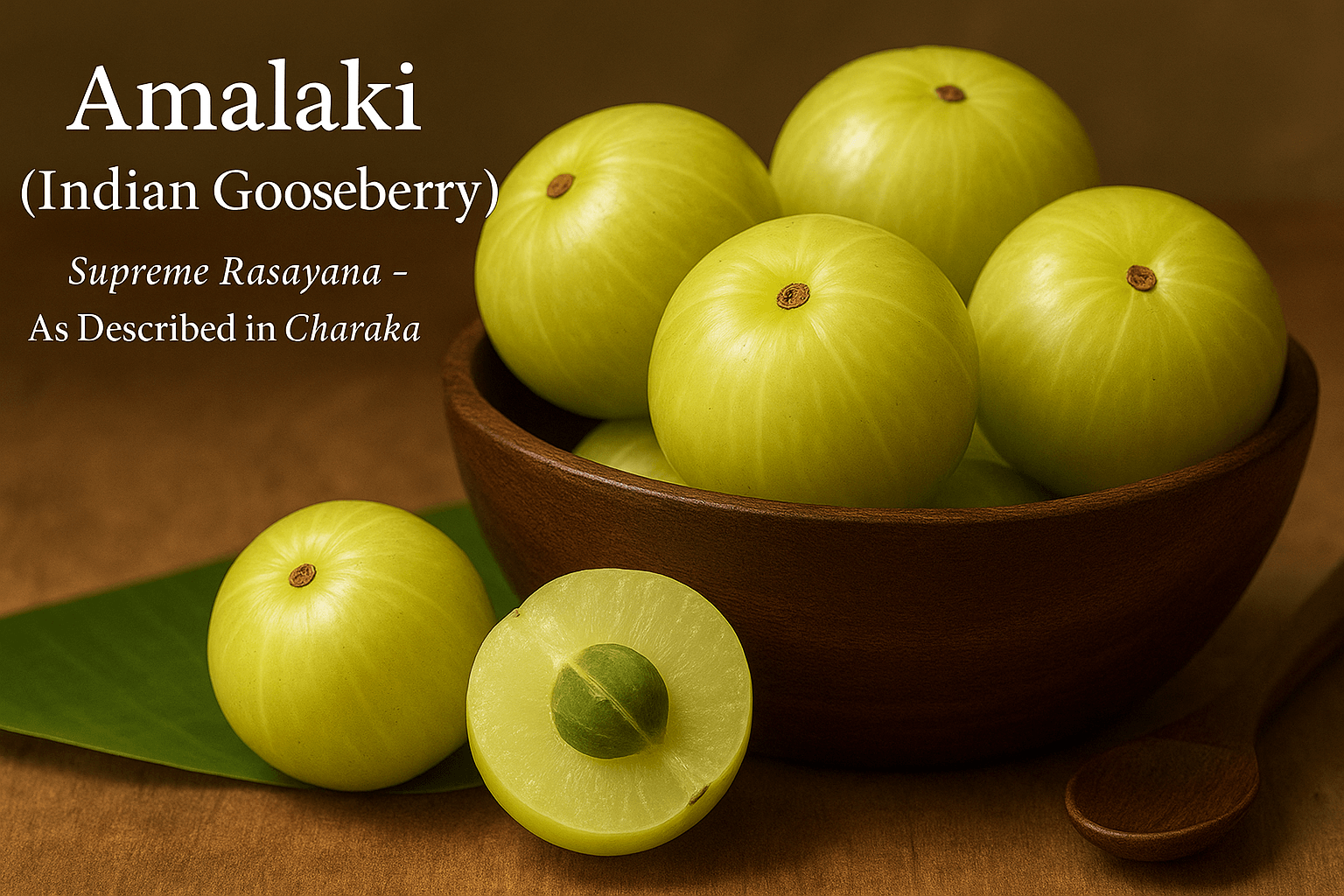





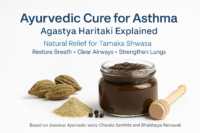
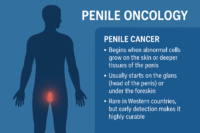
One Response
Thank you for the information very useful thought.